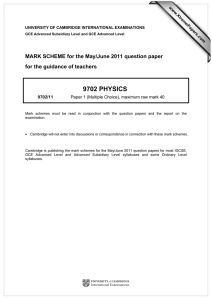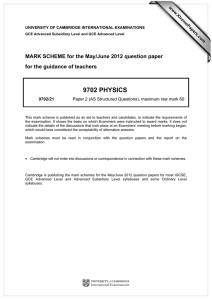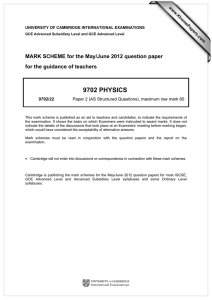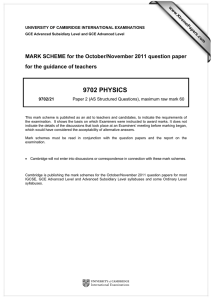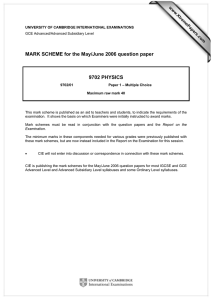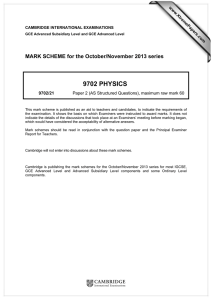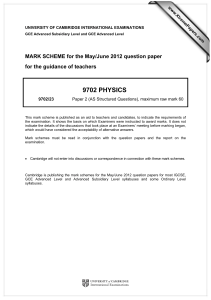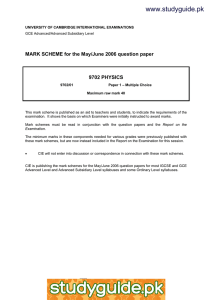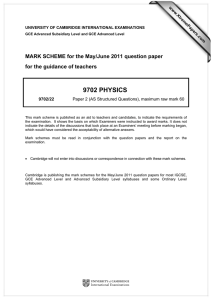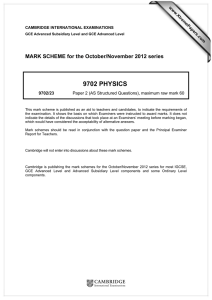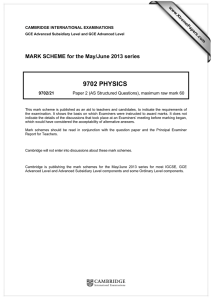9702 PHYSICS MARK SCHEME for the May/June 2014 series
advertisement
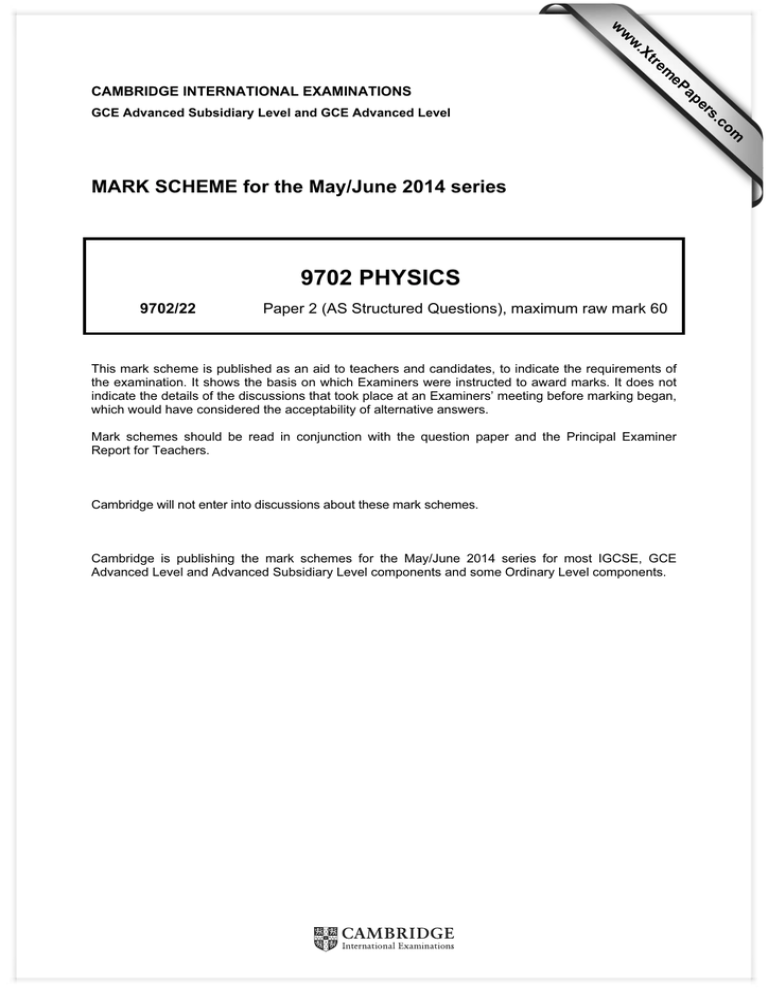
w w ap eP m e tr .X w CAMBRIDGE INTERNATIONAL EXAMINATIONS 9702 PHYSICS 9702/22 Paper 2 (AS Structured Questions), maximum raw mark 60 This mark scheme is published as an aid to teachers and candidates, to indicate the requirements of the examination. It shows the basis on which Examiners were instructed to award marks. It does not indicate the details of the discussions that took place at an Examiners’ meeting before marking began, which would have considered the acceptability of alternative answers. Mark schemes should be read in conjunction with the question paper and the Principal Examiner Report for Teachers. Cambridge will not enter into discussions about these mark schemes. Cambridge is publishing the mark schemes for the May/June 2014 series for most IGCSE, GCE Advanced Level and Advanced Subsidiary Level components and some Ordinary Level components. om .c MARK SCHEME for the May/June 2014 series s er GCE Advanced Subsidiary Level and GCE Advanced Level Page 2 1 2 Mark Scheme GCE AS/A LEVEL – May/June 2014 Syllabus 9702 (a) power = energy / time or work done / time force: kg m s–2 (including from mg in mgh or Fv) 1 or kinetic energy ( mv2): kg (m s–1)2 2 (distance: m and (time) –1: s–1) and hence power: kg m s–2 m s–1 = kg m2 s–3 B1 B1 B1 [3] (b) Q / t : kg m2 s–3 A: m2 and x: m and T: K correct substitution into C = (Qx) / tAT or equivalent, or with cancellation units of C : kg m s–3 K–1 C1 C1 C1 A1 [4] (a) ρ = m / V V = (π d 2 / 4) × t = 7.67 × 10–7 m3 ρ = (9.6 × 10–3) / [π(22.1/2 × 10–3)2 × 2.00 × 10–3] ρ = 12513 kg m–3 (allow 2 or more s.f.) C1 C1 A1 (b) (i) ∆ρ / ρ = ∆m / m + ∆t / t + 2∆d / d C1 = 5.21% + 0.50% + 0.905% [or correct fractional uncertainties] = 6.6% (6.61%) [3] C1 A1 [3] A1 [1] (a) a body / mass / object continues (at rest or) at constant / uniform velocity unless acted on by a resultant force B1 [1] (b) (i) weight vertically down normal / reaction / contact (force) perpendicular / normal to the slope B1 B1 [2] acceleration = gradient or (v – u) / t or ∆v / t = (6.0 – 0.8) / (2.0 – 0.0) = 2.6 m s–2 C1 M1 [2] F = ma = 65 × 2.6 = 169 N (allow to 2 or 3 s.f.) A1 [1] weight component seen: mg sinθ (218 N) 218 – R = 169 R = 49 N (require 2 s.f.) C1 C1 A1 [3] (ii) ρ = 12 500 ± 800 kg m–3 3 Paper 22 (ii) 1. 2. 3. © Cambridge International Examinations 2014 Page 3 4 Mark Scheme GCE AS/A LEVEL – May/June 2014 Syllabus 9702 (a) GPE: energy of a mass due to its position in a gravitational field KE: energy (a mass has) due to its motion / speed / velocity (b) (i) 1. KE = = s C1 1 × 0.4 × (30)2 2 C1 =0+ A1 1 × 9.81 × (2.16)2 2 or s = (30 sin 45°)2 / (2 × 9.81) = 22.88 (22.9) m C1 GPE = mgh = 0.4 × 9.81 × 22.88 = 89.8 (90) J C1 A1 [2] KE = initial KE – GPE = 180 – 90 = 90 J A1 [1] (horizontal) velocity is not zero / (object) is still moving / answer explained in terms of conservation of energy B1 [1] (a) (Young modulus / E =) stress / strain B1 [1] (b) (i) stress = F / A or = F / (π d2/4) or = F / (π d2) M1 2. ratio = 4 (or 4:1) A1 (ii) E is the same for both wires (as same material) [e.g. EP = EQ] strain = stress / E ratio = 4 (or 4:1) [must be same as (i)] 6 [3] [2] (ii) 1. = 22.94 (22.9) m [2] A1 3. 5 B1 B1 1 mv2 2 = 180 J 2. Paper 22 [2] M1 A1 [2] (a) there are no lost volts / energy lost in the battery or there are no lost volts / energy lost in the internal resistance B1 [1] (b) the current / I decreases (as R increases) p.d. decreases (as R increases) M1 A1 or the parallel resistance (of X and R) increases p.d. across parallel resistors increases, so p.d. (across Y) decreases © Cambridge International Examinations 2014 M1 A1 [2] Page 4 Mark Scheme GCE AS/A LEVEL – May/June 2014 Syllabus 9702 (c) (i) current = 2.4 (A) p.d. across AB = 24 – 2.4 × 6 = 9.6 V Paper 22 C1 M1 or total resistance = 10 Ω (= 24 V / 2.4 A) (parallel resistance = 4 Ω), p.d. = 24 × (4 / 10) = 9.6 V (ii) R (AB) = 9.6 / 2.4 = 4.0 Ω 1 / 6 + 1 / X = 1 / 4 [must correctly substitute for R] X = 12 Ω C1 M1 [2] C1 C1 A1 or IR = 9.6 / 6.0 = 1.6 (A) IX = 2.4 – 1.6 = 0.8 (A) X (= 9.6 / 0.8) = 12 Ω (C1) (C1) (A1) (iii) power = VI or EI or V 2 / R or E 2 / R or І 2R = 24 × 2.4 or (24)2 / 10 or (2.4)2 × 10 = 57.6 W (allow 2 or more s.f.) C1 A1 (d) power decreases [2] M0 e.m.f. constant or power = 24 × current, and current decreases or e.m.f. constant or power = 242 / resistance, and resistance increases 7 [3] A1 (a) waves from the double slit are coherent / constant phase difference B1 waves (from each slit) overlap / superpose / meet (not interfere) B1 [1] maximum / bright fringe where path difference is nλ or phase difference is n360U / 2πn rad or minimum / dark fringe where path difference is (n + 1 )λ 2 or phase difference is (2n + 1) 180U / (2n + 1)π rad B1 [3] (b) v = fλ λ = (3 × 108) / 670 × 1012 = 448 (or 450) (nm) C1 M1 [2] (c) w = 12 / 9 a (= Dλ / w) = (2.8 × 450 × 10–9) / (12 / 9 × 10–3) [allow nm, mm] = 9.5 × 10–4 m [9.4 × 10–4 m using λ = 448 nm] C1 C1 A1 [3] (d) (red light has) larger / higher / longer wavelength (must be comparison) fringes further apart / larger separation M1 A1 [2] © Cambridge International Examinations 2014
